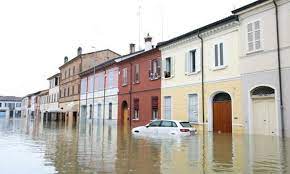Italy: Everything you need to know as ‘apocalyptic’ floods leave 36,000 homeless

Rome: People are being advised to limit their travels in northern Italy, following devastating floods which have killed at least 14 people and forced 36,000 to evacuate their homes.
Earlier this week, 6 months’ worth of rain fell in 36 hours in the region of Emilia-Romagna. Many rivers have burst their banks, submerging entire towns and making some villages and hamlets entirely inaccessible. Though thousands of volunteers have started cleanup, the region remains on red alert on Sunday.
“Apocalyptic” floods and landslides have also wreaked havoc in Croatia, Bosnia and Slovenia, with experts warning that climate-related disasters are on the rise in southern Europe.
In the region’s capital city of Bologna, the tourist board has urged citizens to limit their travel to essential journeys only.

The UK government has issued a travel warning, saying “It is advised to stay away from riverbanks and green areas affected by flooding. Traffic, including between Bologna and Rimini, is likely to be affected.” They urged people to check before they travel and follow instructions issued by local authorities. If you do decide to travel, make sure you have full travel insurance.
Some travellers – including Formula One fans – have cancelled plans to visit the region. The Emilia-Romagna F1 Grand Prix scheduled for this weekend has been called off as emergency crews are already overstretched by the crisis.
Italia Rail warns that High Speed, InterCity and regional trains are experiencing delays, route restrictions, and cancellations in the Emilia-Romagna region. A statement on 17 May advises people not to travel during the next few days if possible. We are awaiting an update to the situation.
Holidaymakers airlines for continuing to run flights to the region, without the option of a refund.
“British Airways are refusing to refund £1518 (€1,747) paid for flights to Bologna today. At least 8 people dead and 13,000 evacuated from the area due to flooding but we’re still expected to travel there for a holiday. Thoughts with everyone suffering in the region,” one British man tweeted this morning.
“[I] bought tickets to Bologna months ago for tomorrow morning. It’s very expensive for my country since we don’t use [the] euro. And now there are floods everywhere [and I don’t know if it’s safe to travel,” another Twitter user wrote.
Those choosing to still travel to the region may find their sightseeing options limited by the floods.
While most of the main tourist attractions remain open today (21 May) in Bologna, the university museums are closed. The historic centre has not been affected and businesses there remain open.
Cityred bus and San Luca express tours are operating and the National Gallery and Asinelli Tower remain open to visitors, according to the Bologna tourist board.
They advise that hiking routes and cycle paths in the area surrounding Bologna are not accessible and should be avoided at all costs.
The popular tourist city of Ravenna, famed for its Byzantine-era mosaics, has been particularly badly affected. More than 27,000 people have been evacuated from their homes and drinking water and food in short supply in some areas.
“Ravenna is unrecognisable after the damage it has suffered,” Mayor Michele de Pascale told RAI public radio.
Emilia-Romagna has borne the brunt of the storm, as red alerts issued by the Italian government show.
But the neighbouring regions of Marche and Tuscany – which were under an amber alert – have also been hit by heavy rainfall.
Further south, the government issued yellow weather warnings for areas including the cities of Rome and Naples. There has also been flooding outside of Italy due to the extreme weather.
In the Balkans, the swollen Una River flooded parts of northern Croatia and north-western Bosnia, where authorities announced a state of emergency.
“We have an apocalypse,” Amin Halitovic told the regional N1 network. “We can no longer count the flooded buildings. It’s never been like this.”
As one of the world’s most popular tourist destinations, many travellers hold Italy close to their hearts.
All donors are advised to include “Alluvione Emilia-Romagna” (“Emilia Romagna flooding”) as the reason for their donation. All funds and their use will be made public by regional authorities.





